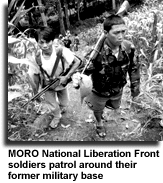| TravelSmart.NET
Archive Home |
|
| Inquirer.NET
Home |
|
| TravelSmart.NET
Home |
|

By Bobby Timonera
Lanao del Sur
 DESPITE the risks, I always look forward to travels
to Lanao del Sur. The people, the culture, the architecture are
different. It is like stepping into another country although it's
just right in my backyard.
DESPITE the risks, I always look forward to travels
to Lanao del Sur. The people, the culture, the architecture are
different. It is like stepping into another country although it's
just right in my backyard.
With a climate similar to Baguio City, Lanao del Sur offers sceneries far better than most of the country's famous tourist spots.
It also plays host to the country's second largest lake, Lake Lanao, 700 meters above sea level.
I've traveled across and around Lake Lanao--by land, water and air--and the view is just wonderful. The beautiful mosques by the lake, the landscape, the lush, green forests.
In the middle of the lake are five tiny islands.
I had longed to go to any of these but times weren't kind them. Some of the islands then were reportedly where the kidnappers brought their captives. In those days, Lanao del Sur was the ''center of kidnappings.''
 My wish came more than a decade later when I was
invited by a group of peace and development volunteers of the
International Organization for Migration to visit Mala Balt (literally,
''Big Island,'' in contrast to neighboring Maito-a-Balt or ''Small
Island'').
My wish came more than a decade later when I was
invited by a group of peace and development volunteers of the
International Organization for Migration to visit Mala Balt (literally,
''Big Island,'' in contrast to neighboring Maito-a-Balt or ''Small
Island'').
Mala Balt is part of Bacolod Kalawi, a coastal town situated along the Marawi-Malabang-Cotabato highway.
To reach Mala Balt, we took a motorized banca at a terminal beside a big mosque in the town center, escorted by about a dozen armed MNLF members. Residents say the ride costs P10, but we were not asked to pay.
I was with a group which was to evaluate the Moro rebels' and residents' proposals for livelihood projects.
The small, narrow boat (10 meters long and 1.5 meters wide) can accommodate maybe 50 people. But newcomers may be afraid to step on the boat, which does not have a balancer. Quite a number of such vessels have sunk in the middle of the lake during unfriendly weather, the latest of which was early this year.
On the island is a big sign that read, ''Camp Morolandia, 2nd Infantry Division, Satellite Command, MNLF BAF.'' BAF stands for Bangsamoro Armed Forces, the MNLF's armed wing. The island, where about a platoon of armed men is based, has been their camp for decades. About 50 families live there.
We toured the island on foot (there are no road) for only a few minutes. Small as it is, the terrain is mountainous, with mango trees all over. Like the seashore, it is windy there.
In the mountainsides are two tunnels, only about 10 meters deep. Hadji Salic Asalan, 70, said the tunnels served as their hideout when government ''Tora-tora'' planes bombed the island twice in the early '70s at the height of the Moro insurrection.
When I took pictures of the tunnels, children went inside and posed eagerly, grinning from ear to ear, unaware that over 20 years ago, right at that place, their parents and grandparents were so terrified of the bombs dropping from heaven.
Today, there is not much activity in the island.
Residents have to cross the lake for their livelihood. Norhelin Ali, 26, buys items at the mainland and sells them to homes on the island.
A small portion of land in the eastern side is planted with corn. A ranch is fenced with barbed wire, but there is no cattle.
Alex Pangcoga, the MNLF unit's security officer, said they harvest about 100,000 kilos of mangoes once a year from the hundreds of trees there.
Happy Sinsuat of IOM said the harvest could be improved significantly if the residents could only be taught agricultural technology.
The women are idle. But they wish to be able to do dressmaking or mat-weaving. Sinsuat suggests that the menfolk go into fishing.
''If only this place could be developed, and the peace and order situation in Lanao del Sur could be improved, this place would really make a good tourist spot,'' said Arab Asalan, former vice mayor of Bacolod Kalawi who stayed on the island for over 10 years.
Will his dream come true?
![]()